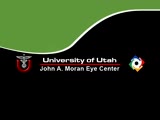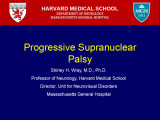TO
Filters: Collection: ehsl_novel_*
| Title | Description | Subject | Collection | ||
|---|---|---|---|---|---|
| 1 |
 |
Progressive Supranuclear Palsy | Progressive Supranuclear Palsy | Progressive Supranuclear Palsy | Neuro-Ophthalmology Virtual Education Library - The Moran Eye Center Neuro-Ophthalmology Collection: https://novel.utah.edu/Moran/ |
| 2 |
 |
Progressive Supranuclear Palsy | Example of patient with progressive supranuclear palsy. Discussion of difference between saccadic movement in supranuclear palsy and nystagmus. Shows saccadic intrusions in forward gaze, pursuit, saccades, and doll's head maneuver. | Progressive Supranuclear Palsy | Neuro-Ophthalmology Virtual Education Library - The Moran Eye Center Neuro-Ophthalmology Collection: https://novel.utah.edu/Moran/ |
| 3 |
 |
Neuropathologic findings in progressive supranuclear palsy. A brief review with two additional case reports. | Older people; Older people, 80 and over; Demyelinating Diseases; Humans; Male; Nerve Degeneration; Neurofibrils; Supranuclear Palsy, Progressive | Neuro-Ophthalmology Virtual Education Library - Journal of Neuro-Ophthalmology Archives: https://novel.utah.edu/jno/ | |
| 4 |
 |
Functional MRI And MRI Tractography In Progressive Supranuclear Palsy-Like Syndrome | Progressive supranuclear palsy (PSP)-like syndrome is a rare disorder which occurs most commonly following ascending aortic aneurysm repair, but may occur after other cardiac procedures. The syndrome, which may manifest immediately after surgery or hours or days later, usually includes supranuclear ... | Progressive Supranuclear Palsy; Aortic Aneurysm; Functional MRI; MRI Tractography; Ophthalmoplegia | Neuro-ophthalmology Virtual Education Library: NOVEL http://NOVEL.utah.edu |
| 5 |
 |
Progressive Supranuclear Palsy (PSP) After Ascending Aorta Dissection Surgery | Progressive supranuclear palsy (PSP) is a rare brain disorder that causes serious and progressive problems with control of gait and balance, along with complex eye movement and thinking problems. We present a case in which developed a neurologic syndrome including PSP after ascending aorta dissectio... | Progressive Supranuclear Palsy (PSP); Ascending Aorta Dissection Surgery; Supranuclear Gaze Palsy; Ataxia; Dysphagia | Neuro-ophthalmology Virtual Education Library: NOVEL http://NOVEL.utah.edu |
| 6 |
 |
Horizontal Vertical and Oblique Saccades in Progressive Supranuclear Palsy | To further our understanding of the eye movement abnormalities occurring in Progressive Supranuclear Palsy (PSP). | Horizontal Saccades; Vertical Saccades; Oblique Saccades; Progressive Supranuclear Palsy; Eye Movement Abnormalities | Neuro-ophthalmology Virtual Education Library: NOVEL http://NOVEL.utah.edu |
| 7 |
 |
Supranuclear Vertical Gaze Palsy | Global Supranuclear Vertical Gaze Palsy; Convergence Absent; Prominent Stare; Slow Hypometric Horizontal Saccades; Slow Horizontal Pursuit; Vertical Oculocephalic Reflex Normal; Positive Glabella Tap; Progressive Supranuclear Palsy; Steele Richardson Olszewski Syndrome; Supranuclear Paralysis of Up ... | Neuro-Ophthalmology Virtual Education Library - Shirley H. Wray Neuro-Ophthalmology Collection: https://novel.utah.edu/Wray/ | |
| 8 |
 |
Unusual CT findings in progressive supranuclear palsy. Case report. | Older people; Brain Diseases; Humans; Male; Ophthalmoplegia; Paralysis; Syndrome; Tomography, X-Ray Computed | Neuro-Ophthalmology Virtual Education Library - Journal of Neuro-Ophthalmology Archives: https://novel.utah.edu/jno/ | |
| 9 |
 |
Progressive Supranuclear Palsy | Progressive Supranuclear Palsy | Neuro-Ophthalmology Virtual Education Library - Shirley H. Wray Neuro-Ophthalmology Collection: https://novel.utah.edu/Wray/ | |
| 10 |
 |
Blink Rates, Ocular Surface Disease, Corneal Sensitivity, and Corneal Nerve Density in Progressive Supranuclear Palsy Patients and Parkinson's Patients | Progressive supranuclear palsy (PSP) and Parkinson's disease have both motor and non-motor features. PSP and Parkinson's patients are frequently diagnosed with dry eye syndrome, but these patients rarely complain of dry eye symptoms. | Progressive Supranuclear Palsy; Blink Rates; Corneal Sensitivity; Corneal Nerve Density; Dry Eye | Neuro-ophthalmology Virtual Education Library: NOVEL http://NOVEL.utah.edu |
| 11 |
 |
Divergence Insufficiency Heralding Progressive Supranuclear Palsy | Progressive supranuclear palsy (PSP) is characterized by slow, hypometric vertical saccades with retained vestibulo-ocular reflexes. Ocular alignment has not been well studied, especially early in the disease. Divergence insufficiency (DI) is not considered typical of PSP, but rather is classically ... | Divergence Insufficiency; Progressive Supranuclear Palsy; Superior Colliculus | Neuro-ophthalmology Virtual Education Library: NOVEL http://NOVEL.utah.edu |
| 12 |
 |
The Effects of Ondansetron, a 5-HT3 Receptor Antagonist, on Progressive Supranuclear Palsy | Progressive Supranuclear Palsy (PSP) is a neurodegenerative characterized by supranuclear gaze palsy, pseudobulbar palsy, dysarthria, dystonic rigidity of the neck and trunk, and dementia. This disorder is often resistant to medical therapy including dopaminergic agents. To date, no medication has b... | Progressive Supranuclear Palsy; PSP; Treatment; Ondansetron | Neuro-ophthalmology Virtual Education Library: NOVEL http://NOVEL.utah.edu |
| 13 |
 |
Partial Blink Rate in Parkinson Disease and Progressive Supranuclear Palsy | Parkinson disease (PD) and progressive supranuclear palsy (PSP) are neurodegenerative diseases that share some motor features. Ocular motility and blink rate dysfunction of these diseases have been characterized, but partial blinks (PB) have not been characterized in the literature. | Parkinson Disease; Progressive Supranuclear Palsy; Partial Blink; Extrapyramidal | Neuro-ophthalmology Virtual Education Library: NOVEL http://NOVEL.utah.edu |
| 14 |
 |
Progressive Supranuclear Palsy | A patient with PSP demonstrates bilateral hypometric saccades, bilateral low-gain pursuit, vertical gaze palsy, and normal vestibulo- ocular reflexes. A second PSP patient is unable to make saccades or pursue horizontally. With optokinetic stimulation, the eyes move somewhat. Cold caloric stimula... | Progressive Supranuclear Palsy; Saccades; Vertical Gaze Palsy | Neuro-Ophthalmology Virtual Education Library: Robert B. Daroff Collection https://novel.utah.edu/Daroff/ |
| 15 |
 |
Progressive Supranuclear Palsy (PSP) | Progressive supranuclear palsy (PSP) is a rare neurodegenerative disorder producing characteristic eye movement abnormalities in the classic presentation. The disease pathologically is marked by accumulation of abnormal tau proteins. There are useful MRI features, however the diagnosis remains clini... | Progressive Supranuclear Palsy; Ophthalmoplegia; Parkinsonism; Dementia; Richardson-Steele-Olszewski Syndrome | Neuro-ophthalmology Virtual Education Library: NOVEL http://NOVEL.utah.edu |
| 16 |
 |
Functional MRI And MRI Tractography In Progressive Supranuclear Palsy-Like Syndrome | Progressive supranuclear palsy (PSP)-like syndrome is a rare disorder which occurs most commonly following ascending aortic aneurysm repair, but may occur after other cardiac procedures. The syndrome, which may manifest immediately after surgery or hours or days later, usually includes supranuclear ... | Progressive Supranuclear Palsy; Aortic Aneurysm; Functional MRI; MRI Tractography; Ophthalmoplegia | Neuro-ophthalmology Virtual Education Library: NOVEL http://NOVEL.utah.edu |
| 17 |
 |
Platform Presentation: Neuro-Ophthalmic Findings that May Reliably Differentiate Progressive Supranuclear Palsy and Parkinson's Disease | Progressive supranuclear palsy (PSP1) causes progressive parkinsonism with prominent early postural instability. The characteristic cardinal feature of PSP, supranuclear vertical gaze palsy, may not appear until later in the course of the disease making an accurate early diagnosis difficult. | Progressive Supranuclear Palsy; Parkinsons Disease; Vertical Saccadic Velocity; Vertical OKN; Square Wave Jerks | Neuro-ophthalmology Virtual Education Library: NOVEL http://NOVEL.utah.edu |
| 18 |
 |
Progressive Supranuclear Palsy | Slideshow describing condition. | Acquired Ocular Motor Apraxia; Apraxia of Eyelid Opening; CNS - Degeneration Convergence absent; Convergence Insufficiency; Global Supranuclear Vertical Gaze Palsy; Impaired Initiation of Horizontal Saccades; Lid Retraction; Positive Glabella Tap; Progressive Supranuclear Palsy - Tauopthay; Progres... | Neuro-ophthalmology Virtual Education Library: NOVEL http://NOVEL.utah.edu |
| 19 |
 |
Supranuclear Paralysis of Up and Downgaze | Positive Glabella Tap; Slow Hypometric Horizontal Saccades; Supranuclear Paralysis of Up and Downgaze Degeneration; Progressive Supranuclear Palsy - Tauopathy; Steele Richardson Olszewski Syndrome; CNS - Degeneration | Neuro-Ophthalmology Virtual Education Library - Shirley H. Wray Neuro-Ophthalmology Collection: https://novel.utah.edu/Wray/ | |
| 20 |
 |
Progressive Supranuclear Palsy (PSP) After Ascending Aorta Dissection Surgery | Progressive supranuclear palsy (PSP) is a rare brain disorder that causes serious and progressive problems with control of gait and balance, along with complex eye movement and thinking problems. We present a case in which developed a neurologic syndrome including PSP after ascending aorta dissectio... | Progressive Supranuclear Palsy (PSP); Ascending Aorta Dissection Surgery; Supranuclear Gaze Palsy; Ataxia; Dysphagia | Neuro-ophthalmology Virtual Education Library: NOVEL http://NOVEL.utah.edu |
| 21 |
 |
PET Scans of Patients with Clinically Diagnosed Progressive Supranuclear Palsy May Show Abnormal Metabolic Asymmetries | We studied 4 women patients (mean age 68) who presented with visual complaints and signs of progressive parkinsonism and supranuclear gaze abnormalities. These patients were clinically suspected to have PROGRESSIVE SUPRANUCLEAR PALSY.(PSP), because of the presence of (1) macrosaccadic square wave j... | Progressive Supranuclear Palsy; Abnormal Metabolic Asymmetries; Positron Emission Tomography; Macrosaccadic Square Wave Jerks; Vertical Gaze Abnormalities; Jerky Horizontal Pursuit | Neuro-ophthalmology Virtual Education Library: NOVEL http://NOVEL.utah.edu |
| 22 |
 |
Walsh & Hoyt: Steele-Richardson-Olszewski Syndrome (Progressive Supranuclear Palsy) | In 1964, Steele, Richardson, and Olszewski reported a group of patients with a late-onset neurodegenerative disease characterized by supranuclear gaze palsy, pseudobulbar palsy, dysarthria, dystonic rigidity of the neck and trunk, and dementia. At postmortem examination, there was neurofibrillary de... | Neurodegenerative Diseases; Metabolic Diseases; Adult; Steele-Richardson-Olszewski Syndrome; Progressive Supranuclear Palsy; Parkinson's Disease; Basal Ganglia Disorders | Neuro-ophthalmology Virtual Education Library: NOVEL http://NOVEL.utah.edu |
| 23 |
 |
Literature Review: Wild Card | Gerstenecker et al tried to correlate genes (microtubule-associated protein tau, myelin-associated oligodendrocyte basic protein, eukaryotic translation initiation factor 2-alpha kinase 2, syntaxin 6, and apolipoprotein E) previously identified as risk alleles in progressive supranuclear palsy and c... | Plasticity; Neuro-immunology; TLR4 Signal; Dominant Optic Atrophy; Progressive Supranuclear Palsy | Neuro-ophthalmology Virtual Education Library: NOVEL http://NOVEL.utah.edu |
| 24 |
 |
Progressive Supranuclear Palsy (PSP) | Objectives:; To provide an overview of PSP and its pathophysiology;; To present typical clinical features of the disease with a focus on ocular findings;; To provide a template for work up, diagnosis and treatment; ; To demonstrate typical eye movement abnormalities seen in PSP | Progressive Supranuclear Palsy (PSP) | Neuro-ophthalmology Virtual Education Library: NOVEL http://NOVEL.utah.edu |
| 25 |
 |
Apraxia Eyelid Opening | Apraxia of Eyelid Opening; Impaired Initiation of Horizontal Saccades; Slow Hypometric Horizontal Saccades; Supranuclear Paralysis of Up and Downgaze Degeneration; Progressive Supranuclear Palsy - Tauopathy; Steele Richardson Olszewski Syndrome; CNS - Degeneration | Neuro-Ophthalmology Virtual Education Library - Shirley H. Wray Neuro-Ophthalmology Collection: https://novel.utah.edu/Wray/ |
